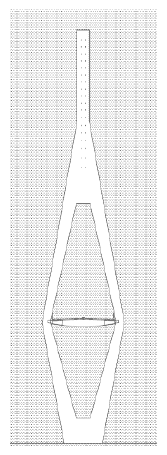6. Assessment of Tower Options 6.1 General 6.2 Mono-Tower 6.3 H-Shape Tower 6.4 Diamond Tower 6.5 A-Shape Tower 6.6 Assessment of Options
6. Assessment of Tower Options
This section is also available in pdf format (3.9mb)
6.1 General
The tower options have been developed considering aesthetics, structural capacity and the space requirements for stay cable anchorages as well as inspection and maintenance facilities. The towers are hollow reinforced concrete structures with the stay cables connected to a fabricated steel anchor box embedded in the upper part of each tower. The use of an anchor box maximises off-site fabrication allowing rapid construction progress and accurate geometry controlled in factory conditions.
Structural demands on the central tower are particularly significant due to the double main span arrangement. At this stage of design the structural sizing of the tower is based upon grade C50/60 concrete and grade 500B 40mm diameter bars which is considered standard practice in the UK. However, concrete grades up to C70/85 are permitted by the relevant UK National Annexes to the Eurocodes and 50mm diameter bars are reasonably common within international practice. Some tendering contractors may opt for higher strength concrete and/or larger diameter bars which will allow reduction in concrete quantities and/or reinforcement densities. However, a more competitive tender should be possible if the tower dimensions allow for "standard" grades and diameters.
For aesthetic reasons the external dimensions of the flanking towers are kept the same as for the governing central tower although thinner wall sizes and/or lower reinforcement densities will be possible. The towers extend 145m above deck level and for all three towers the external geometry of each upper tower is identical. Due to the vertical profile of the bridge the height of the lower tower below deck varies. The vertical alignment of the bridge has been made symmetrical over the two main spans so that the height of the two flanking towers is identical but there is a difference between these and the central tower. The geometry of the lower tower is therefore slightly different but the variation is achieved in a subtle manner to suit the bridge profile and so the aesthetics of the towers is not compromised.
The space required for stay cable anchorages as well as inspection and maintenance access facilities govern the dimensions required at the tower top, particularly in the transverse direction. For each tower a rack and pinion inspection and maintenance lift will be provided from deck level to the tower top. Sizing is based on a minimum car size of 0.78 x 1.30 m which is sufficient for 5 persons. Intermediate lift stops together with the required access platforms will be provided to give access to the stay cable anchorages which are spread out over a vertical height of up to 60 m. In addition, emergency ladders must be accommodated to provide access/escape in the event of mechanical failure of the lift. The stay anchor box itself is sized to allow stressing of the stays at the tower top and provision is made for bringing large tension adjustment jacks to the anchor head.
The flanking tower foundations are submerged below low-tide level and the central tower foundation shaped to merge with the profile of Beamer Rock. This allows the towers to emerge uninterrupted from the water at all states of tide and avoid a bulky waterline object interfering with the aesthetic form. A consequence of this is that at high tide the tower legs could potentially be exposed to relatively significant ship impact forces. A connecting element is required between the tower legs to provide the necessary robustness for the H-Shape and A-Frame towers.
Figures showing the architectural development of the various tower forms are included in Appendix B.
6.2 Mono-Tower
6.2.1 Form
In the original Multi-Modal Scheme Assessment, a Needle Tower which pierced the wide deck was recommended as the preferred structural arrangement.
With the D2M functional cross section under investigation, a similar layout would be to have a mono-tower at the bridge centre-line, with one carriageway on either side. This will provide a narrow tower which does not visually dominate the existing Forth Bridges.
The mono-tower is being considered with either a single wide deck or a twin deck. The most notable example of a twin deck arrangement with mono-tower is Stonecutters Bridge, currently under construction in Hong Kong.
Stonecutters Bridge: Mono-tower with twin deck
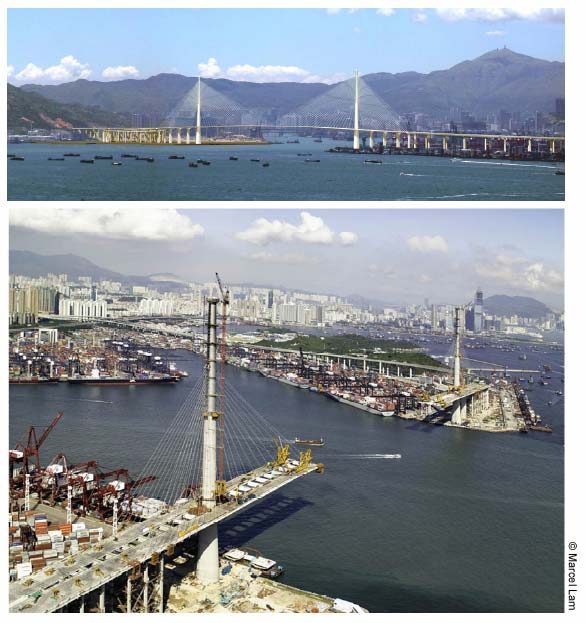
Mono-tower cable stayed bridges have also been applied in the past for single decks, for example the Brotonne Bridge in France with a 320m main span in concrete.
Brotonne Bridge: Mono-tower with single deck

For the single deck the tower creates dead area which leads to a desire for the tower to be as slender as possible and it can be seen that this was taken to the limit for the Brotonne Bridge. However, the relative mass of the tower both above and below deck needs to be considered and from some angles the Brotonne Bridge towers look disproportionate. More pleasing continuity of the tower through the deck is achieved by the Second Panama Canal Bridge, also with a 320 m main span.
It may also be possible to use the dead area on the bridge as maintenance access by providing a penetration through the tower to allow a maintenance vehicle to pass. The feasibility of this arrangement was investigated with respect to whether the structural strength of the tower is compromised and the practicality of accessing this zone which is between the carriageways. In a similar fashion the dead area could be used for a future single track tram / LRT line. Although this arrangement proved to be feasible it has not been assumed for the Scheme Assessment.
Second Panama Bridge: Mono-tower with single deck
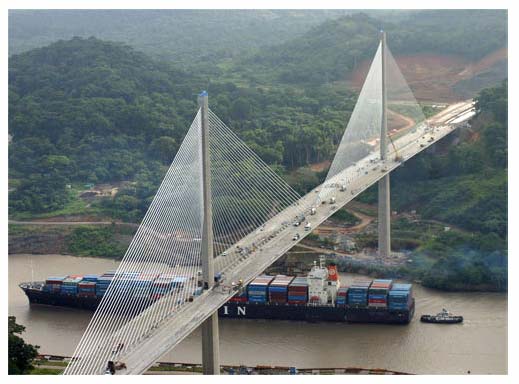
One of the key distinctions between the single deck and the twin deck solution will be in the disposition of the stay cable planes. For the single deck it is possible to have the stay cables anchored close to the centreline of the bridge. For the twin deck and ladder beam options the reduced torsional stiffness of the deck leads to the stay cables being anchored along the outside edges of the deck.
This distinction could potentially lead to different tower forms being developed for each option. For the central stay cables there is very little variation in transverse cable angle between the long and the short stays and a flat edge detail to the tower shape is suitable as illustrated below:
Tower shape M1 with cables arranged for a single deck
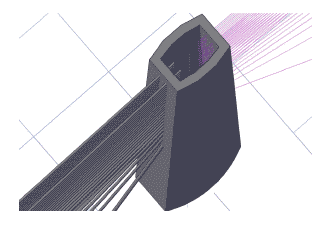
For edge stay cables there is more variation in the cable angles with the shorter cables having a significant transverse angle. If the same tower shape as shown above (M1) were used then some of the cables would conflict with the corner which would be undesirable both visually and structurally. A more rounded section shape (M2) avoids this and allows a smooth interface. The different shapes are illustrated in drawings FRC/C/076/D2M/201 and FRC/C/076/D2M/202 in Appendix D.
Tower shape M1 (left) and M2 (right) with cables arranged for a twin deck
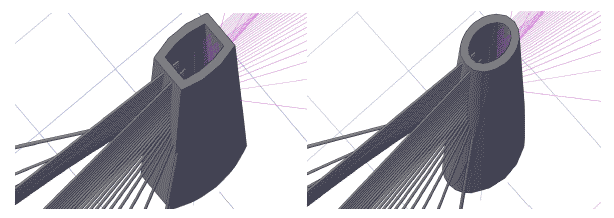
6.2.2 Structural behaviour
(a) Tower slenderness
The mono-tower is designed to be unusually slender in the transverse direction for a large cantilever structure with a height to width ratio of 20:1 above deck for the narrowest solution. This requires particular consideration of the second order effects due to slenderness.
A generalised method using non-linear analysis is allowed by the Eurocode and such a method has been followed considering three key slenderness effects:
- Amplification of displacements due to non-linear cross section behaviour
(moment-curvature) - Amplification of bending moments due to displacement of axial loads
(P-delta effects) - Introduction of additional bending moments due to initial imperfections
(elastic-critical buckling analysis)
Initially an elastic critical buckling analysis has been carried out to give some indication of the sensitivity to these effects. The load factors for the critical buckling modes, which are transverse buckling of the central tower followed by that of the flanking towers, are between 3 and 5 depending on the scheme and stay cable arrangement. This represents the factor by which the applied loads would be multiplied in order to induce elastic buckling.
Towers of cable stayed bridges are generally longitudinally stabilised by the deck via the stay cables. The stabilisation effect in the transverse direction is much smaller due to the small angles of the stay cables in transverse direction. The study of the different arrangements of the cables shows that the transverse stabilisation effect depends on the arrangement of the cables. If the cables are attached to the outside of the deck the tower receives a greater stabilisation effect (due to the greater angle of the cables) than with cables attached to the inside of the deck.
The non-linear analysis method results in significant amplification of the moments which are produced by a first-order linear analysis, with the transverse moment increased by up to 50%. However, although slenderness effects are shown to be significant, the tower is structurally adequate at reasonable reinforcement ratios.
(b) Structural demand
The high structural demand in the central tower occurs both in the upper tower approximately 105m above deck level and in the lower tower immediately below deck. In both cases the critical loading is traffic load on one main span only as illustrated below:
Stay forces and tower moments for traffic on one span

In the span being loaded the shorter, steeper stays deliver load to the central tower whereas in the opposite main span it is the longer, shallower stays which transfer the load to the crossing stay region. The result is a large bending moment in the upper tower due to the vertical spread of the stay cable anchorages.
The relative flexibility of the structure results in the central tower being pulled towards the loaded span which results in bending moment in the tower. This moment is increased due to framing action with the deck provided by a monolithic joint. The result is a large bending moment immediately below deck level.
The behaviour is similar for all deck types but the axial forces due to permanent loads in the tower are higher for composite options whereas the longitudinal flexural moments due to live load described above are slightly higher for orthotropic deck options. Transverse flexural forces due to wind are similar for all deck types. The increased axial load for the composite deck is dominant and results in higher structural quantities in the tower.
(c) Stay cable anchorage arrangement
As described above, the vertical distribution of the stay cable anchorages is important in determining the bending moment in the upper tower. It is proposed that the stay cables be anchored in a fabricated steel anchor box structure which will act compositely with the upper tower. This is a common arrangement which is adopted on Pont de Normandie and Stonecutters Bridge amongst many others. An exercise was carried out to determine the preferred anchor box height considering a balance between ease of fabrication and maintenance of the anchor box versus reduction in structural demands on the tower. The result was a height difference of 60 m between the highest and lowest stay anchor points.
(d) Vortex shedding
Vortex shedding is a low wind speed phenomenon that can potentially lead to vibrations of a tall slender structural element like the Mono-Tower. The possibility of vortex shedding induced vibrations of the tower will require study and the cross section shape will be developed to reduce the amplitude of vibrations if practical. Alternatively a tuned mass damper could be incorporated in the tower. One of the major concerns of vibration of the tower would be resonance of the stay cables if they have matching frequencies. At this stage it has been established that the fundamental tower frequency is below the range of stay cable frequencies. However, it is still possible that higher order tower vibration modes could resonate with the stays. Whilst the amplitude of tower vibrations in the higher order modes is expected to be small, the possibility of resonance requires further study and will inform the design of the stay cable dampers.
6.3 H-Shape Tower
6.3.1 Form
For the H-Shape tower, the previous tower developed for the double deck option in the Multi-Modal Scheme Assessment is taken as a point of reference for further development. Compared to this tower (as illustrated below) the revised tower will be slightly narrower due to the reduction in deck width from 35.2 m to 30.2 m (measured from the inside face of the windshield). This will result in a reduced foundation footprint as well as a more slender form.
Multi-Modal Scheme Assessment: H-Shape Tower
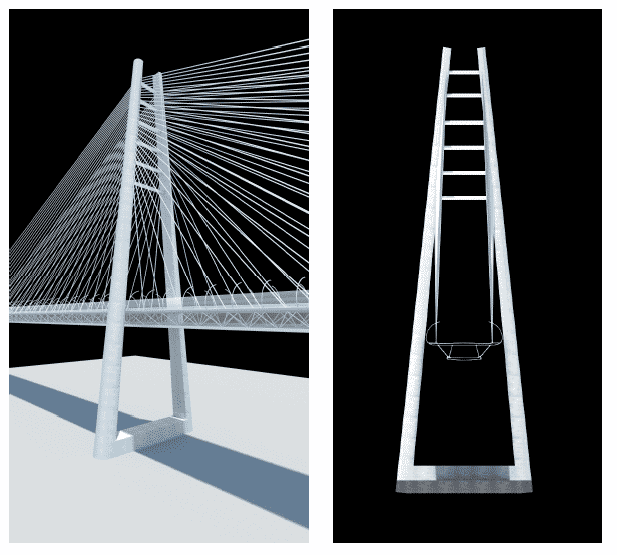
Since slenderness of the tower form is important to the tower aesthetics, the deck width passing between the tower legs is reduced to a minimum. This is achieved by the stay cables being anchored in the shadow of the tower legs and the deck width being reduced at the tower.
The form considered for the current Scheme Assessment is shown in drawing FRC/C/076/D2M/211 in Appendix D.
6.3.2 Structural behaviour
(a) Global torsional performance
It is a well established phenomenon that the torsional restraint provided to the deck by stay cables anchored at the deck edges depends upon whether the stay planes on opposite edges of the deck are anchored to a common member in the tower (single leg) or to two discrete members (twin legs).
When anchored to a common member, the tower will not displace longitudinally in the deck torsional mode and only the main span stays will be strained. However, when anchored to two discrete members the side span stays will also be strained with one tower leg moving forwards whilst the other moves backwards. The stiffness of the system is significantly reduced. This behaviour is illustrated below:
Conventional interaction between tower and torsion mode for a two leg tower

Analysis of the H-Shape Tower has shown that this effect is amplified for the double main span bridge. The fundamental torsional mode consists of each main span rotating in opposite directions. The central tower then follows the deck with the central stay cable fans being strained only as a second order effect due to the torsional stiffness of the tower. This is illustrated below, where it can be seen that much larger displacements of the central tower occur compared to the flanking towers.
Double main span interaction between tower and torsion mode for a two leg tower

The implication of this behaviour is that for the H-Shape Tower, the torsional stiffness of the global system will be heavily dependent on the torsional stiffness of the deck. Therefore the ladder beam deck cannot feasibly be combined with the H-Shape Tower.
(b) Structural demand and stay anchorage arrangement
The structural demand in the longitudinal direction is similar to the Mono-Tower with the crossing stays resulting in significant bending moments in the upper part of the tower. The stay anchorage arrangement is therefore also similar, with the stays distributed over a height of 60 m.
In the transverse direction, structural investigations have concentrated on the feasibility of eliminating any cross beam at deck level.
Aesthetically it is desirable for there to be no visible cross beam at deck level so that the deck floats through the tower. A slender tie-beam within the depth of the deck could be considered but this complicates the erection of the deck around the tower.
The loading and slenderness effects in the tower were investigated as well as the vierendeel moments induced in the steel cross beams in the upper part of the tower. It was concluded that a cross beam at deck level is not necessary.
For further development of the tower the major issue to resolve is the connection between the steel cross beams and the tower legs. It is assumed that the cross beams would be connected directly to the steel anchor box in the upper part of the tower.
6.4 Diamond Tower
6.4.1 Form
There are many types of diamond shaped cable stayed bridge towers around the world and the proportions of the bridge (tower height, deck width, deck height) have a major impact on the aesthetics of the tower. Studies of the possible solutions for the specific proportions of the Forth Replacement Crossing suggest that although a tower could be developed which in itself would be aesthetically pleasing, the strong diamond image would be reminiscent of other bridge towers around the world and it would be difficult to develop something that would be unique and instantly recognisable as the Forth Replacement Crossing.
The studies carried out considered varying the proportions of the diamond. Initially three sequences were considered, each commencing with a common starting point:
Sequence 1: Raising the upper leg intersection point with a "closed" base

Sequence 2: Raising the upper leg intersection point with an "open" base
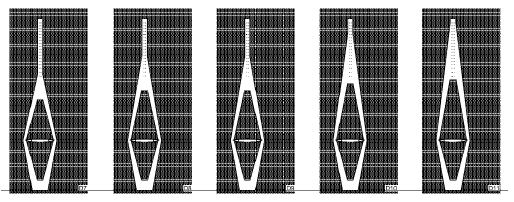
Sequence 3: Lowering the upper leg intersection point with a "stem" base

For all of the forms considered a common feature is that the deck is located at the bend in the tower leg and there is no visible cross beam. This would either be achieved by a cross beam within the depth of the deck or else by a very slender tie beam immediately below the deck. A common alternative is to have a substantial cross beam below the deck and for the bend in the tower leg to be at the height of the cross beam. This is aesthetically awkward as the deck then appears to be too high in comparison to the tower.
After the initial studies, two diamond forms were studied in more detail, one with conventional proportions arising from Sequence 1 and the other with more unusual proportions arising from Sequence 3, emphasising the tower as a single vertical element, in a similar fashion to the Needle Tower of the Multi-Modal Base Case but with the split in the tower at deck level having to be significantly wider.
|
|
Conventional Diamond |
Needle Diamond |
The horizontal tie force required for the Needle Diamond is significantly larger than for the Conventional Diamond due to the larger angle through which the compressive force in the tower leg must be turned. This force proved to be incompatible with the desire for the cross beam not to be visible and the more conventional proportions were adopted for the tower form.
The form considered for the current Scheme Assessment is shown in drawing FRC/C/076/D2M/241 in Appendix D.
6.4.2 Structural behaviour
With the tower legs joined together at the base of the anchor box, the tower is a stiff element and will not participate in the fundamental deck torsional mode.
The structural demand in the longitudinal direction is similar to the Mono-Tower with the crossing stays resulting in significant bending moments in the upper part of the tower. The stay cable anchorage arrangement is therefore also similar, with the stays distributed over a height of approximately 60 m.
Transversely, the major consideration is the tie force at deck level which is still significant even with the more conventional proportions which have been adopted. It would be in no way practical to eliminate the cross beam as has been achieved for the H-Shape tower but at the same time it is desired that the cross beam is not visible.
The cross beam has been developed as a slender element. In that way it can act as a tie between the legs without developing portal framing moments which would require the cross beam to be very substantial. By making the tie sufficiently slender it can penetrate through the webs of the deck and therefore be hidden within the depth of the deck girder.
6.5 A-Shape Tower
6.5.1 Form
Since it is not technically feasible to combine the H-Shape Tower with a ladder beam deck, an A-Frame tower has been developed as a variation on the H-Shape form which can support this deck type. By joining the legs at the top of the tower the mode of vibration illustrated in Section 6.3.2(a) above is suppressed.
In general the form is similar to the H-Shape with the inclination of the tower legs increased. This is beneficial in joining the legs at the tower top but results in a wider footprint which is both a technical and aesthetic compromise compared to the H-Shape form.
The form considered for the current Scheme Assessment is shown in drawing FRC/C/076/D2M/261 in Appendix D.
6.5.2 Structural behaviour
The behaviour is similar to the H-Shape tower with the following technical differences:
- Increased foundations costs due to slightly wider footprint
- Increased tower construction duration due to more complex work at tower top (note this is unlikely to be on the critical path)
- Feasible to be combined with the ladder beam deck
6.6 Assessment of Options
6.6.1 Technical Comparison
The Mono-Tower is a single vertical structural element which results in the easiest and fastest construction methods and lowest structural quantities.
Higher quantities and costs are associated with the H-Shape Tower because they include two discrete elements. However, the construction duration is similar since the two legs can be built in parallel. The steel cross beams which connect the H-Shape tower legs can be pre-fabricated and installed as the tower construction progresses. The situation with the A-Frame tower is similar although the tower construction takes longer because it is necessary to construct the significant in-situ concrete element at the tower top. However, since stay cable erection can commence before it is necessary to construct this element it does not affect the critical path. The most complex construction is associated with the Diamond Tower where the deviation at deck level introduces a cross beam and also the tower legs must be joined at the bottom of the anchor box before stay cable erection can commence. This results in the tower construction duration being longer and impacting the critical path.
The width of the H-Shape and A-Frame towers at foundation level are approximately 55 m and 60 m respectively which is much larger than the required size for a single pilecap / footing. Thus, for the flanking towers two independent pilecaps are proposed connected together by a structural beam at waterline which also acts to strengthen the tower legs against ship impact. The overall length of the foundation is greater than for the Mono-Tower / Diamond options, which potentially increases the vulnerability to ship impacts, since impacts with the corner of the pilecap may act at a greater eccentricity to the overall pile group and produce a larger twisting effect on the foundation. This, combined with the heavier loads from the increased self-weight of the two legged towers, results in the need for greater numbers of piles. For the central tower, the greater width results in the tower straddling the high point of Beamer Rock with the spread footing foundations needing to be constructed at a lower elevation on the flanks of the rock. This will require more complex temporary works and greater difficulty during rock excavation. The larger footprint also results in greater reinforcement quantities in the region of the tower most susceptible to corrosion, for which stainless steel reinforcement is being considered.
The H-Shape Tower cannot be combined with the ladder beam deck.
The relative differences are summarised below:
Functional Cross Section |
Two Corridor |
Single Corridor |
||
|---|---|---|---|---|
Issue |
Mono-Tower |
H-Shape |
Diamond |
A-Frame |
Tower Cost |
Low |
Highest |
High |
High |
Foundation Cost |
Low |
High |
Low |
Highest |
Tower Construction Duration |
Shortest |
Short |
Longest and affects critical path |
Longer but does not affect critical path |
Can be combined with any deck type? |
Yes |
No – cannot be combined with ladder beam |
Yes |
Yes |
Technically the Mono-Tower scores well on all counts. The H-Shape and A-Frame tower may be valid alternatives since although the tower itself is more costly, there could be savings in the deck for the Single Corridor functional cross section. The Diamond Tower is unlikely to be a technically reasonable alternative due to the prolongation of the overall construction schedule (described in more detail in Section 1.33).
6.6.2 Aesthetic Comparison
The objective of the aesthetic design of the main crossing is to build a bridge that will be elegant, unique and instantly recognisable as the Forth Replacement Crossing. At the same time it will fulfil all the functional requirements in a way that delivers value for money in whole life terms, having full regard to sustainability, buildability and maintainability. The setting for the crossing is a world-famous landscape and the required standard of aesthetics is high.
It is fitting that the overall form of the new bridge heralds the 21st Century, just as the rail bridge is a memorial to19th Century engineering and the suspension bridge relates to the 20th Century.
It is also important that, in addition to being an aesthetically pleasing and iconic structure, the scale of the new bridge is sympathetic to the surrounding landscape and complementary to the form of the existing road and rail bridges. In particular, the towers must not dominate the slender towers of the existing road bridge.
The new bridge will be seen from many locations, both locally and at a distance from settlements, roads and hills in the landscape around the Forth estuary.
Historically, viewpoints at North and South Queensferry have enabled the closest and most dramatic views of the existing bridges.
However, from the north, the new bridge will be viewed most closely from Queensferry Hotel and Admiralty House (also known as St Margaret’s Hope), west of North Queensferry, while the majority of North Queensferry will have more distant views beyond one or both of the existing crossings.
From the south, the new crossing would be most visible from the north-west of South Queensferry, Port Edgar marina, Linn Mill, and Inchgarvie House.
Travellers using the new bridge, the existing road bridge or sailing on the Forth close to these bridges will also be able to view the new bridge in close proximity.
From distant views the new bridge should be in scale with the existing bridges and the towers of the new bridge should be slim and must not dominate the towers of the existing road bridge which being of steel construction are particularly slender.
For the Mono-Tower Option, the penetration of the tower through the deck is the key to achieving this. The slim tower which can be achieved would be in scale with the towers of the existing road bridge. Moreover the shallow depth of the deck will be like a blade across the water, uninterrupted by tower legs straddling either side. The aesthetic ideal of the tower is a single element piercing the blade-like deck. The most novel feature of the bridge will be the crossing stays which have never before been adopted on a bridge of this scale. The Mono-Tower combined with the single deck gives the best emphasis to this unique feature.
For the several options developed for the Single Corridor, the H-Shape Tower appears to offer a good aesthetic solution. The development of this tower form is an exercise in self restraint. With the tower having two vertical elements, it is even more critical that the tower should be simple in form to avoid dominating the towers of the existing road bridge. This is achieved with a simple conical form, sliced through with a plane on the inner face to create a shadow line and encase the deck. The cross beams which are required structurally have been developed as slim minimalistic tubes. The resulting form is a clear visual separation between the deck and the tower with their different tasks in the overall structure.
The A-Frame tower is a variant of the H-Shape which has been developed to allow it to support the ladder beam deck which cannot feasibly be combined with the H-Shape. However, when considering appearance alone, the original solution of the H-Shape is preferred since more pleasing proportions are achieved and a heavy mass at the top of the tower is avoided.
As has been described earlier, the Diamond Tower will be a visually striking shape. Whilst it may be possible to develop an aesthetically pleasing form it is unlikely to be unique and it may also tend to dominate the very slim towers of the adjacent road bridge.
Comparison of tower forms

6.6.3 Summary
All four tower options are feasible but technical differences do exist between them.
The Mono-Tower is the most favourable solution both technically and aesthetically.
However, if an alternate tower form is adopted to allow the Single Corridor functional cross section to be progressed then the H-Shape Tower appears preferable. Although the foundations will be more costly than the Diamond Tower, the saving in construction programme will be decisive. With the H-Shape Tower unable to support a ladder beam deck, the A-Frame variant would be recommended if the single corridor ladder beam proved advantageous.
